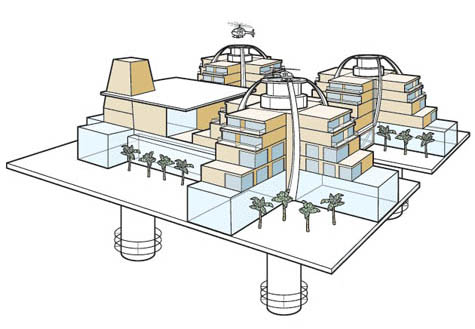 [Image: The basic platform; design your seastead atop this and win $1000].
[Image: The basic platform; design your seastead atop this and win $1000].The Seasteading Institute is sponsoring a design competition to see who can most interestingly visualize a permanent, microsovereign architectural state at sea.
"A seastead," they write in the competition brief, "is a floating platform that allows people to permanently settle the ocean as they do land. Professional naval engineers have already designed a bare platform – a structure about 400x400 feet, roughly the size of a city block. What you build on the platform is up to you. It may be a hospital, a casino, a residential community, a cricket stadium, or something entirely different."
 [Image: The sample design].
[Image: The sample design].There are some basic engineering constraints that participants will have to heed, as explained both in the call-for-entries and in this forum, and a sample design has been supplied (see images above and below).
But I think it'd be absolutely fascinating to annualize this, and launch a kind of eVolo competition for offshore platform design. The skyscraper designs that come out of eVolo might gravitate a bit too strongly toward the biomorphic/diagrid/arbitrary fractal tiling end of contemporary architectural design, but each year's results are always worth checking out.
So if architects were asked to rethink the spatial design of offshore libertarian self-rule, and to do so as part of a high-profile annual competition, what sorts of structures might we see?
 [Image: An illustrated variation of the sample design, from Wired magazine].
[Image: An illustrated variation of the sample design, from Wired magazine].For a little more background, Wired's Chris Baker covered the Seasteading Institute last month. Baker wrote that the Institute "doesn't just want to create huge floating platforms that people can live on," they are "also hoping to create a platform in the sense that Linux is a platform: a base upon which people can build their own innovative forms of governance. The ultimate goal is to create standards and blueprints that can be easily adapted, allowing small communities to rapidly incubate and test new models of self-rule with the same ease that a programmer in his garage can whip up a Facebook app."
Here, architectural design would actually help to catalyze new forms of political sovereignty.
The cultural possibilities for these offshore spaces are effectively without limit – and they would be self-policed, falling outside the bounds of international law. This opens up a number of legal (not to mention moral) quandaries.
Baker reports that Patri Friedman, the Institute's co-founder and executive director, speaking at a Bay Area conference held last fall, "notes that some enterprises – like euthanasia clinics – would incense local authorities, but almost all the ideas attendees [at that conference] come up with would capitalize on activities that skirt existing laws and regulations: Fish farming and aquaculture. Prisons. Med schools. Gold warehouses. Brothels. Cryonics intakes. Gene therapy, cloning, augmentation, and organ sales. Baby farms. Deafeningly loud concerts. Rehab/detox clinics. Zen retreats. Abortion clinics. Ultimate ultimate fighting tournaments."
So what might these platforms look like? Submissions are due by May 1.
No comments:
Post a Comment